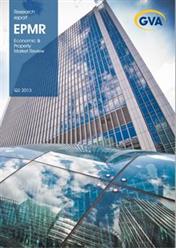Research report EPMR Q2 2013
Positive economic growth between Q4 2012 and Q1 2013 was a welcome relief from a feared triple dip recession, even if growth was only a weak 0.3%. This means that over the last two years UK economic output has only increased by 1.1%, or an annual average of just 0.5%. This compares to an annual average of 3% in the decade before the 2008 recession.
However, North Sea oil and gas extraction has declined by 21% over the last two years. If this is excluded slightly healthier economic growth of 1.5% has been achieved. The other main drags on economic growth over the last two years have been manufacturing output (-3.1%) and construction (-10.1%), whereas the service sector has increased by 2.9% in total, with business services and finance showing the strongest growth of 3.5%, but with finance much weaker than business services.
In Q1 2013 sector output growth was similar to the pattern over the last two years. However, when compared to the quarterly sector averages in the 10 years before the recession started (i.e. up to the end of 2007), the current economic weakness is dramatically illustrated.
Ironically, just as output growth went positive in Q1, employment growth went negative and unemployment increased, reversing the trend of the last 18 months when total employment increased by 600,000.
However, surprisingly strong employment growth has a downside, which is very weak pay growth and declining productivity.
Total annual pay growth was only 0.4% over the latest three month period, compared to CPI inflation of 2.8% pa and RPI inflation of 3.3% pa, meaning a large fall in earnings in real terms, as the second chart shows. This indicates a strong squeeze on household purchasing power and is in marked contrast with the previous two post recession upturns when household spending growth played an important role. It is hardly surprising that retail spending growth has recently been weak, compounding the problems for the retail property market from a strong growth in internet sales.
The consequence of weak economic growth has been no underlying improvement in the budget deficit and a further increase in the national debt. The IMF is now of the view that severe austerity policies may be counter productive for the UK, especially when similar policies are being pursued in the Euro area, our main export market.
As a result, their latest forecast for the UK is for only 0.7% economic growth this year and 1.5% next year, and even weaker growth in the Euro area, where -0.3% and 1.1% respectively is expected. This
contrasts with a relatively healthy 1.9% and 3% in the USA.
The government’s response to growing concerns about very weak economic growth has been to try to free up bank lending, particularly to small and medium sized firms, but also to homeowners to increase effective housing demand and so boost house building. The lack of bank lending is seen as a main stumbling block to stronger economic output growth.
The Funding for Lending scheme has had only a small effect on bank lending so far, due to the perceived risks of lending to smaller companies and arguably weak demand from smaller businesses for higher borrowing due to lack of confidence. The recent budget provided increased incentives for banks to lend to small and medium sized companies, but the general view is that these policies will only have a limited effect.
The latest consensus forecasts for economic growth are similar to the IMF’s – a slow and weak improvement over the next two years at least. As the third chart indicates, this will mean only a slight improvement in occupier demand for property outside London and slowly increasing levels of UK rental growth.
Return to top ↑

